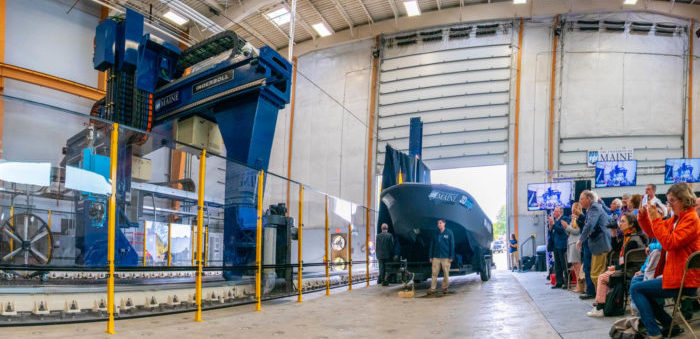The University of Maine System Advanced Structures and Composites Center was awarded with three World Records on Oct. 10 for the world’s largest prototype polymer 3D printer, largest solid 3D-printed object, and largest 3D-printed boat.
The awarded printed printed the world’s largest 25-foot, 5,000-pound 3D-printed boat, named 3Dirigo. The vessel was being printed for 72 hours.
The printer is designed to print objects as long as 100 feet by 22 feet wide by 10 feet high, and can print at 500 pounds per hour. The printer will have an active role in various initiatives, including development of biobased feedstocks using cellulose derived from wood resources, and rapid prototyping of civilian, defence and infrastructure applications.
The biobased feedstocks are economical and recyclable, while they boost the competitive advantages of Maine’s manufacturing industries, including boatbuilding.
[smlsubform prepend=”GET THE SAFETY4SEA IN YOUR INBOX!” showname=false emailtxt=”” emailholder=”Enter your email address” showsubmit=true submittxt=”Submit” jsthanks=false thankyou=”Thank you for subscribing to our mailing list”]
In the meantime, the Maine Technology Institute (MTI) provide a $500,000 grant to UMaine Composites Center for the construction of a technology cluster to help Maine boatbuilders explore how large-scale 3D printing using economical, wood-filled plastics can provide the industry with a competitive advantage.
The cluster will unite experts of UMaine researchers and marine industry leaders to further develop and commercialize 3D printing to benefit boatbuilders in the state. 3D printing of plastics with 50% wood is produced faster and more economical, in comparison to today’s methods.
During the ceremony, the University also presented a 3D-printed, 12-foot-long U.S. Army communications shelter. The printer will be used by the U.S. Army Corps of Engineers and will further advance innovations in rapidly deployable, low-logistics infrastructure systems. That includes a 5,000-pound, 21-foot-long 3D-printed mold for a new 76-foot-long composites bridge girder. The girder has been licensed to a University of Maine spinoff company, Advanced Infrastructure Technology, that is in the process of fabricating girders for a bridge to be constructed in Hampden, Maine, in summer 2020. In addition, rapid production of stay-in-place concrete formwork is a potential solution for both infrastructure and coastal resiliency construction applications.
See also:




























































